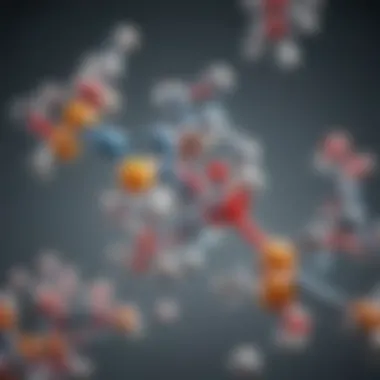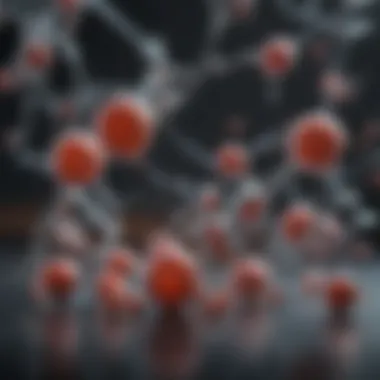Aminoketone: Structure, Function, and Applications


Intro
Aminoketones are an intriguing category of organic compounds, noteworthy for the simultaneous presence of ketone and amine functional groups. This combination gives rise to a diverse array of chemical properties and biological activities. In the context of medicinal chemistry and industrial applications, aminoketones play significant roles. Understanding their structure can reveal insights into their synthesis, interactions, and potential implications in multiple fields.
To fully appreciate the relevance of aminoketones in contemporary research, it is essential to examine their underlying chemistry as well as their practical applications. This article aims to provide a detailed guide to the structure, function, and various uses of aminoketones, paving the way for deeper exploration of their capabilities.
Prelims to Aminoketones
Aminoketones are notable in organic chemistry for their unique structure that incorporates both ketone and amine functional groups. Their dual functionality lends them a wide spectrum of chemical properties and biological activities. In this article, we will explore the components that make aminoketones significant in various fields, particularly in medicinal chemistry and industrial applications. Understanding aminoketones not only highlights their importance but also reveals their potential for innovative applications in research and technology.
Definition and Classification
Aminoketones are organic compounds characterized by the presence of both an amino group (–N) and a ketone group (–C=O). This structural feature classifies them as a subset of carboxylic derivatives, embodying key properties of both amines and ketones.
These compounds can be further classified based on their structure:
- Monoketone Amines: Possessing one ketone group and one amino group.
- Polyaminoketones: Containing multiple amino groups attached to the ketone backbone.
The arrangement and type of substituents attached to the core structure also influence their classification, opening paths to various derivatives that do not merely expand their chemical diversity but also enhance their functional properties.
Historical Context and Discovery
The study and identification of aminoketones dates back to early organic chemistry, where researchers began to uncover the connections between structure and biological activity. Early 20th-century discoveries laid groundwork for understanding these compounds. Advances in synthetic methodologies allowed for the first time the creation of aminoketones in controlled lab environments.
One noteworthy milestone was the emergence of 1-phenyl-2-aminopropan-1-one, a simple yet impactful aminoketone. This molecule highlighted the potential of aminoketones in contributing to both medicinal chemistry and material science.
The exploration of aminoketones continues, with ongoing research paving the way for novel applications and deeper comprehension of their biochemical roles. Understanding their history and discovery aids researchers in predicting their behavior and interactions in diverse biological contexts.
Chemical Structure of Aminoketones
The chemical structure of aminoketones is central to understanding their properties and applications. These compounds consist of both a ketone group and an amine group, giving them unique characteristics that can be leveraged in various fields, particularly in medicinal chemistry and industrial processes. The specifics of their molecular architecture are not just an academic curiosity; they directly influence how these compounds interact with cells, enzymes, and other chemical substances in biological systems. Therefore, a detailed examination of the chemical structure is key to exploiting their full potential.
Molecular Composition
Aminoketones have specific molecular formulas that dictate their behavior. Typically, they include a carbonyl group (C=O), which is characteristic of ketones, alongside an amine group (-N). This combination facilitates multiple sites for chemical reactivity. The molecular formula of an aminoketone may include carbon, hydrogen, nitrogen, and oxygen atoms, contributing to their diverse chemical behavior.
Moreover, the positioning of these functional groups is vital. For instance, the placement of the ketone group affects the compound's polarity and solubility. Understanding the molecular composition allows researchers to predict how these substances will behave in metabolic pathways and how they might further interact in diverse chemical processes. This aspect can be crucial for drug formulation and efficacy.
Functional Groups Involved
The presence of functional groups in aminoketones is a determining factor in their chemical activity. The ketone and amine groups serve distinct purposes:
- Ketone group: This group plays a pivotal role in electrophilic reactivity. Its sp2 hybridization enables interactions with nucleophiles, making aminoketones reactive and versatile.
- Amine group: This group introduces basicity, which is important in biological interactions. The availability of a lone pair of electrons on the nitrogen atom can involve the compound in various reaction pathways, including nucleophilic substitutions.
Additionally, other potential functional groups may be attached to the aminoketone structure, influencing their reactivity and applications further. Each modification can change the compound's properties, emphasizing the importance of understanding these functional groups for practical applications.
Stereochemistry and Isomerism
Stereochemistry is a crucial concern in the study of aminoketones. The presence of multiple functional groups can lead to various isomers, which are compounds with the same molecular formula but different structural arrangements. This variability can affect the biological activity significantly. For instance, different isomers may have distinct effects on receptor binding or metabolic stability.
- Geometric Isomerism: This occurs due to restricted rotation around the carbonyl bond, leading to cis and trans variations, which can affect the compound's interaction with biological systems.
- Optical Isomerism: If a chiral center is present, aminoketones can exist as enantiomers. These enantiomers often exhibit drastically different pharmacological effects, an aspect that is of great importance in drug development.
Understanding the implications of stereochemistry and isomerism not only aids in biological function studies but also directs the synthesis of specific isomers for targeted therapeutic applications.
"The structural intricacies of aminoketones provide immense potential for tailored drug design and application in medicinal chemistry."
This overview of chemical structure serves as a foundational layer for the subsequent discussion on synthesis and applications, ensuring that the reader understands why these details matter.
Synthesis of Aminoketones
The synthesis of aminoketones forms a critical foundation for understanding their applications in various scientific domains, particularly in medicinal chemistry and industry. The process of creating these compounds involves a careful selection of methods and pathways, optimizing yield and purity. This section elucidates the importance, techniques, and innovative approaches in synthesizing aminoketones, guiding researchers and students in their quest for knowledge.
Synthetic Pathways


Multiple synthetic pathways exist for the creation of aminoketones. Each method offers distinct benefits and challenges based on the desired molecular properties. Notable pathways include:
- Reactions involving carbonyl compounds: These methods typically use ketones as starting materials, reacting them with different amine sources, and resulting in diverse aminoketones.
- One-pot multicomponent reactions (MCRs): This efficient approach combines reactants in a single reaction vessel. This reduces the number of steps needed, often improving overall yields.
- C–N bond formation techniques: These pathways aim to create the critical carbon-nitrogen bond, fundamental to all aminoketones. Techniques such as nucleophilic substitutions or coupling reactions serve this role well.
Each synthetic route serves to highlight the versatility and adaptability of aminoketones in chemical synthesis, informing future research directions.
Catalytic Methods
Catalytic methods are key in aminoketone synthesis. The use of catalysts enhances the reaction rate and can improve product selectivity. Common catalysts include:
- Transition metals such as palladium and platinum, which facilitate the formation of C–N bonds.
- Organocatalysts, which provide an eco-friendlier alternative by promoting reactions without heavy metals. Organocatalysis can be particularly useful in avoiding unwanted side reactions, making them favorable for sensitive substrates.
Employing these catalytic methods not only optimizes the synthesis process but also aligns with green chemistry principles, reducing waste and energy consumption.
Alternative Synthesis Techniques
Alternative techniques in aminoketone synthesis have gained traction due to advances in research. These methods broaden the creative landscape for organic chemists. Some noteworthy approaches include:
- Microwave-assisted synthesis: This technique uses microwave energy to shorten reaction times while enhancing yields. The rapid heating can drive reactions that are otherwise slow, offering a significant efficiency boost.
- Ultrasound-assisted reactions: This method utilizes ultrasound waves to increase reaction rates and improve yields. The application of ultrasound can promote mixing and enhance the activation energy required for certain chemical transformations.
Both methods illustrate innovation in the field, further showcasing the ongoing evolution of synthetic chemistry. Future research may reveal even more efficient alternatives, increasing both the accessibility and diversity of aminoketones in various applications.
"The field of aminoketone synthesis not only pushes the boundaries of organic chemistry but also opens pathways to significant advancements in pharmaceutical development and industrial applications."
In summary, the synthesis of aminoketones is a multifaceted subject that encompasses various pathways, catalytic methods, and emerging techniques. Each aspect contributes to a deeper understanding of these compounds and their vital roles in healthcare and technology.
Role in Biological Systems
Aminoketones serve critical functions within biological systems, influencing various metabolic and biochemical processes. Their presence is not merely incidental; rather, it is intertwined with multiple cellular activities that can have significant implications for both health and disease. Understanding how aminoketones operate at this level is pivotal for both the scientific community and pharmaceutical applications.
Aminoketones in Metabolic Pathways
The integration of aminoketones in metabolic pathways reveals their role as both substrates and products in crucial reactions. These compounds participate in pathways such as the citric acid cycle and amino acid metabolism. Their dual nature, characterized by the amine and ketone groups, facilitates unique chemical reactions that prop up cellular energy production and biomass synthesis.
For instance, during amino acid catabolism, certain aminoketones can serve as intermediates. These intermediates are integral to the synthesis of key biomolecules. Moreover, their involvement in energy-producing pathways hints at their potential as metabolic regulators.
Interactions with Enzymatic Processes
Aminoketones are not just passive entities; they actively engage with enzymes to influence biochemical reactions. This interaction can range from acting as substrates for specific enzymes to serving as inhibitors or activators of enzyme activity. Their structural properties allow them to fit into the active sites of enzymes, ensuring that the chemical reactions are efficiently catalyzed.
For example, certain aminoketones can affect the kinetics of lactate dehydrogenase, an essential enzyme in glycolysis and the citric acid cycle. This modulation can alter metabolic flux, impacting energy production pathways significantly. Understanding these interactions opens up avenues for targeted therapeutic interventions, particularly in diseases where metabolic dysregulation occurs.
Impact on Cellular Functions
The broad biological roles of aminoketones extend to their influence on cellular functions. They can modulate signaling pathways, impact gene expression, and affect cellular growth. These effects may stem from their ability to interact with various biological molecules, including nucleic acids and proteins.
Main influences include:
- Regulation of enzyme functions
- Modulation of metabolic pathways
- Potential effects on cellular division and differentiation
The impact of aminoketones is particularly relevant in the context of cellular stress responses and adaptability. By participating in signaling networks, they may help cells adapt to environmental changes or stressors.
"The diverse roles of aminoketones underscore their importance in metabolic regulation and cellular homeostasis."
In summary, aminoketones are crucial components of metabolic processes and enzymatic interactions. Their significance in biological systems is multifaceted, affecting a wide range of cellular functions. Research in this area is essential not only to grasp basic biological principles but also to explore therapeutic possibilities to address metabolic disorders.
Applications in Medicinal Chemistry
The field of medicinal chemistry continually evolves, incorporating new findings in biology and chemistry. Among the diverse classes of organic molecules, aminoketones present notable relevance due to their unique structural features and versatile biological activities. Understanding the involvement of aminoketones in various pharmacological contexts is crucial for both academic inquiry and practical applications in drug design.
Pharmacological Uses
Aminoketones exhibit significant pharmacological properties, making them valuable for medical applications. Their structure, which contains both amine and ketone groups, facilitates interactions with biological targets. This dual functionality allows aminoketones to act on various receptors and pathways within biological systems.
Some common pharmacological uses include:


- Antidepressants: Certain aminoketones can modulate neurotransmitter levels in the brain, showing efficacy in treating depression. Bupropion is a well-known aminoketone used as an antidepressant and smoking cessation aid.
- Anesthesia: Other derivatives have been useful in anesthetic protocols due to their ability to alter neuronal signaling.
The specific actions of aminoketones often depend on their molecular configuration and how they interact with target proteins and enzymes.
Development of Therapeutics
The development of new therapeutics often leans on the libraries of existing compounds. Aminoketones' unique properties make them attractive candidates for further investigation. Researchers can modify their structure to enhance therapeutic effects while reducing adverse effects.
The following strategies are common in this development process:
- Structure-Activity Relationship Studies (SAR): This approach allows researchers to correlate chemical structure with biological activity. By systematically altering functional groups within the aminoketone structure, it is possible to identify more effective compounds.
- High-Throughput Screening (HTS): Researchers often employ HTS to rapidly assess the activity of numerous aminoketone derivatives against various biological targets.
Such methods have led to the discovery of mechanistically different compounds aimed at treating conditions like anxiety, schizophrenia, and other neurological disorders.
Case Studies of Successful Drugs
Examining successful drugs derived from aminoketones provides insights into the practical applications of this compound class. For instance, Bupropion demonstrates how one aminoketone can significantly influence the pharmacological landscape.
- Bupropion: This aminoketone acts primarily as a norepinephrine-dopamine reuptake inhibitor, supporting its use in treating depression and aiding smoking cessation.
- Other examples: Research into new aminoketone derivatives continues, aiming to expand therapeutic applications further. These compounds are being investigated for their potential in oncology and other chronic conditions.
Aminoketones demonstrate both the potential for novel therapeutic strategies and the continued importance of structural analysis in drug development.
Industrial Uses of Aminoketones
The industrial applications of aminoketones encompass a wide range of sectors, including manufacturing, chemical industries, and materials science. Their unique properties, deriving from the combination of ketone and amine groups, allow them to function effectively as intermediates, catalysts, and solvents in various chemical processes. Understanding these applications is critical for enhancing efficiency and sustainability in industrial practices.
In Manufacturing Processes
Aminoketones play a vital role in manufacturing processes, primarily as building blocks in the synthesis of complex organic molecules. They often facilitate reactions that are crucial in producing pharmaceuticals and agrochemicals. Their physical and chemical properties, such as solubility and reactivity, make them ideal for integration into different production methodologies.
- Key functions within manufacturing processes include:
- Acting as intermediates in the production of various compounds
- Serving as reagents in chemical reactions, increasing reaction rates
- Enhancing the solubility of reactants, thereby improving yield and purity
Their utility extends to the polymer industry, where specific aminoketones contribute to the development of polymer additives. These additives enhance the performance characteristics of polymers in terms of stability and durability.
Role in Chemical Industries
In the chemical industries, aminoketones are utilized extensively due to their dual functional groups. They are involved in numerous processes, including solvent extraction and chemical synthesis. Their ability to interact with a variety of substrates facilitates the development of diverse chemical reactions, which are essential for producing various products.
Some prominent roles include:
- Solvents and Extractants: Aminoketones serve as effective solvents in reaction mixtures, aiding the separation and purification of products. This is particularly useful in the extraction of active pharmaceutical ingredients from complex mixtures.
- Catalysts: Certain aminoketones have catalytic properties that can be harnessed in organic synthesis. They promote specific reactions, leading to higher yields and reduced by-products, which is essential for cost-effective and environmentally friendly processes.
Aminoketones in Materials Science
Aminoketones also find their application in materials science, where they are essential in developing innovative materials with tailored properties. Their unique chemical structure allows them to be integrated into polymers and composites, resulting in materials that exhibit improved performance and longevity.
- Applications in materials science include:
- Serving as cross-linking agents in polymer formulations
- Enhancing the thermal and mechanical properties of composite materials
- Functioning as flame retardants, which is crucial in safety-sensitive applications
Research continues to explore the potential of aminoketones in creating smart materials, which respond to stimuli such as temperature or light. This area offers exciting possibilities for advancements in various technologies, including sensors and actuators.
The integration of aminoketones in industrial applications is shaping the future of manufacturing, enabling the development of more efficient and sustainable processes.
Safety and Toxicology of Aminoketones
The evaluation of safety and toxicology of aminoketones is crucial in ensuring their safe use in various applications, particularly in pharmaceuticals and industrial processes. With increasing utilization of these compounds, understanding their toxicological profiles becomes necessary for risk assessment and regulatory compliance. Evaluating the safety parameters is vital to avoid adverse effects on human health and the environment. The complexity in their structure can lead to varied toxicological effects which should be characterized.
Assessing Toxic Profiles
To assess the toxic profiles of aminoketones, several methodologies are used. These include in vitro assays and in vivo studies.


- In vitro assays help in understanding cellular responses to aminoketones. These assays reveal effects on cell viability, proliferation, and apoptosis in cultured cell lines. They are generally quicker and less costly compared to in vivo tests.
- In vivo studies provide a comprehensive insight into the systemic effects of aminoketones on living organisms. Such studies involve testing various doses to determine the toxic threshold, thus allowing for better safety evaluations.
Toxicity tests may look at acute and chronic effects. Acute toxicity tests help in determining immediate harmful effects following a single exposure. Chronic tests, on the other hand, evaluate long-term exposure effects. It is also important to consider bioaccumulation potential of these compounds. The overall goal is to define safety limits and create guidelines for handling and usage.
"Understanding the toxicological profiles helps mitigate risks associated with aminoketones, guiding safe handling practices across industries."
Regulatory Considerations
The regulatory framework surrounding aminoketones is guided by various entities that focus on human health and environmental safety. Agencies like the U.S. Environmental Protection Agency (EPA) and the European Chemicals Agency (ECHA) evaluate chemical safety based on toxicological data.
Some key regulatory considerations include:
- Risk Assessment: Each aminoketone must undergo a risk assessment process to evaluate potential hazards. This includes not only toxicity data but also exposure scenarios based on intended applications.
- Material Safety Data Sheets (MSDS): Proper documentation that outlines safety protocols is essential. MSDS for aminoketones should detail handling procedures, potential hazards, and emergency measures.
- Labeling Requirements: Clear labeling is important to inform users about hazards. Labeling should comply with local regulations to ensure safe usage, especially in industrial settings.
- Long-term Monitoring and Reporting: Continuous monitoring of aminoketone use and effects is critical. Businesses are encouraged to report any adverse effects encountered during usage to relevant regulatory bodies.
Future Directions in Aminoketone Research
Research into aminoketones is evolving rapidly, paving the way for new insights and applications. The significance of exploring future directions in this field cannot be overstated. As the understanding of these compounds deepens, their potential in various scientific disciplines can be better realized. This section will outline emerging research areas, innovations in synthesis, and the role of interdisciplinary collaborations.
Emerging Research Areas
One promising area of research involves the relationship between aminoketones and neurodegenerative diseases. Studies suggest these compounds may influence cognitive functions and protect neuronal health. Understanding their mechanisms may uncover novel therapeutic pathways.
Additionally, the integration of aminoketones in drug design is gaining traction. By elucidating their interactions with biological targets, researchers can develop more effective therapeutics. Potential studies could focus on creating compounds with enhanced specificity and reduced side effects.
Here are some emerging research themes:
- Neuroscience: Investigating the impact of aminoketones on brain function.
- Pharmacology: Evaluating their efficacy in targeted drug delivery systems.
- Biotechnology: Utilizing aminoketones in biosensors for environmental monitoring.
Potential Innovations in Synthesis
The synthesis of aminoketones can benefit from innovative and efficient methodologies. Advances in organic synthesis techniques could lead to higher yields and purities of desired compounds. For example, exploring green chemistry principles may reduce waste in aminoketone production.
Innovations in synthesis include:
- Microreactor Technology: Facilitating continuous flow synthesis, which allows for better control of reaction conditions.
- Biocatalytic Approaches: Leveraging enzymes for specific transformations, improving selectivity and reducing the need for hazardous reagents.
- Novel Catalysts Development: Investigating new catalytic materials that enhance reaction efficiency.
The ultimate goal of these innovations is to streamline the production of aminoketones, making them more accessible for various applications in medicine and industry.
Interdisciplinary Collaborations
Collaboration across disciplines will be essential for advancing aminoketone research. Chemists, biologists, pharmacologists, and material scientists can come together to explore the multifaceted roles of these compounds. Such diversity enhances idea generation and contributes to holistic understanding.
Examples of potential collaborative areas include:
- Materials Science: Developing aminoketone-based polymers with specific properties for medical devices.
- Nanotechnology: Creating delivery systems for drugs that utilize aminoketones as key components.
- Environmental Science: Analyzing aminoketones' interactions in ecosystems, helping assess their environmental impact.
Through interdisciplinary approaches, researchers can address complex questions, fostering innovation and real-world applications in aminoketone chemistry.
"The future response to today's needs in aminoketone research lies in the collaborative efforts of diverse scientific fields, driving forward the frontiers of knowledge and applications."
Overall, the future of aminoketone research appears bright. With focused research on emerging areas, innovations in synthesis, and robust interdisciplinary collaborations, the potential to unlock the full scope of aminoketones is considerable. As understanding increases, expectations of what these compounds can achieve in various fields will expand.
Closure
In this article, we have followed the intricate journey of aminoketones, revealing their multifaceted nature and significance. Understanding the chemical structure, synthesis processes, and applications of aminoketones provides a timeless perspective on their utility in both pharmaceutical and industrial contexts.
Summarizing Key Points
Aminoketones, characterized by the dual presence of ketone and amine functional groups, are critically important in various domains. Here are the key takeaways from our exploration:
- Chemical Structure: The molecular composition emphasizes the versatility of aminoketones, which can lead to diverse reactive properties.
- Synthesis Methods: We discussed multiple synthetic pathways, highlighting how innovations can enhance efficiency and yield.
- Biological Roles: Aminoketones play crucial roles in metabolic pathways and various enzymatic interactions, showcasing their importance in cellular functions.
- Medicinal Applications: Their pharmacological uses reveal their therapeutic potential, making them indispensable in drug development and formulation.
- Safety Considerations: Assessing the toxic profiles and regulatory aspects ensures that the application of aminoketones aligns with health standards.
- Future Directions: Emerging research areas present new opportunities for discoveries, innovations, and interdisciplinary collaborations.
Final Thoughts on Aminoketone Research
The research on aminoketones opens doors to exciting possibilities. As scientific understanding deepens, it is imperative to focus on sustainable synthesis methods and explore novel applications.
Continued emphasis on aminoketone compounds will likely lead to breakthroughs in therapeutic agents and industrial processes. The synergy of chemical exploration and practical applications will enrich future studies while addressing current challenges.
Furthermore, collaboration across disciplines can enhance insights into amino ketone behavior in biological systems. This aspect remains essential as new methodologies in chemical synthesis arise, potentially accelerating the discovery of life-saving drugs.
In summary, the role of aminoketones extends far beyond their chemical classification. Their potential remains immense, signaling the necessity for ongoing research and commitment to understanding their impact in varied fields.







